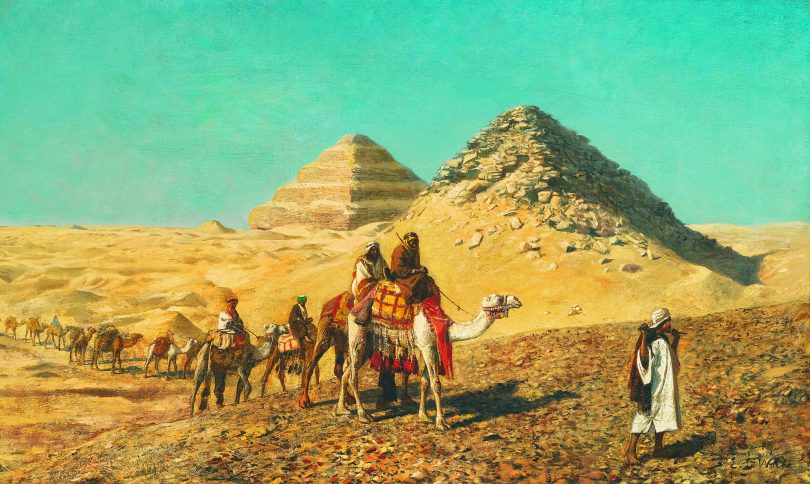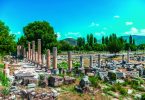The largest city of the Arab world and Africa, draws all the attention with its history, with the region it was established in, and the traces of past civilizations it hosts. Are you ready to go on a little journey in the history of this one-of-a-kind city?
FIRST THERE WAS FUSTAT
In Prophet Umar’s period, Islamic armies under the command of Amr ibn al-Âs conquered Egypt, and established the first Islamic city in the southern Nile delta (643) naming it Fustat. Earlier civilizations which passed into Egyptian history, had established their capitals at Fustat. First, a mosque named after Amr ibn al-Âs was built in Fustat which was the first mosque of Egypt and Africa. The mosque was followed by administrative buildings and garrisons. In short, this was a garrison city built to shelter the soldiers.
CITY OF THE ELITE: CAIRO
After this initial settlement, every state that ruled in the region built their own capitals near Fustat and their monuments in these cities. In the year 969, the Fatimids who entered Egypt, launched the construction of a palace and city walls again near Fustat, and established their capital here. The name of this new city was “Cairo” which means the oppressor and crusher of enemies. Surrounded by city walls, new city Cairo was a city only statesmen, commanders, soldiers and those at the service of the caliph could enter as the others needed special permission. Moreover, the people of Fustat were not allowed in the city.
CENTRE OF ISLAM WORLD
After Saladdin Ayyubid conquered Egypt in 1171, the Ayyubid period began in Cairo. Shortly after, the Mamluk started to rule in the city. During Mamluk period, the city grew and expanded. New mosques and madrasahs were built. Bulak port which was essential in city’s economy, was also built during Mamluk period. When Baghdad was invaded by the Mongolian, Abbasids moved caliphate’s centre to Cairo. It remained as the centre of Islam world for a long time.
OTTOMANS ON THE HORIZON
In the Classical Age, the main rival of the Ottoman Empire in the East was Iran and the Mamluks allied with Iran acting against the Ottoman. The Ottoman decided to defeat the Mamluks before a campaign on Iran, and campaigned under the command of Sultan Selim I. Ottoman ambassadors sent to Mamluk Sultan Tuman Bay, delivered him the message that if he was to surrender, he would become the Egyptian regent under the Ottoman Sultan. After the letter was read, Tuman Bay ordered the execution of messengers. He shot the messenger, and the sword was out of the sheath.
Two armies confronted at the ground called Ridaniya before Cairo. Mamluk army had little chance against the Ottoman army which could move quickly and successfully change tactics. The Ottoman army entered the city after a day of fighting ( January 23rd, 1517). The battle continued inside the city for nearly three days. Consequently, the city was taken by the Ottomans. With the city, the caliphate also passed to the Ottomans, and Sultan Selim I was the first caliph of the dynasty and a servant of caliphate.
Particularly in late 19th and early 20th centuries, in works by some researchers there were biased, negative impressions on the Ottoman period in Cairo. Allegedly, Cairo was the centre of a reign encompassing the entire Middle East, however it was reduced to a centre of a state in the post-Ottoman era, with diminished resources and reduced income. However, recent studies conducted on the documents in the Ottoman archives indicate that the Ottomans claimed an insignificant part of the income, and a large part of tax collected from the country was allocated to Cairo. In fact, the Ottomans built works in harmony with local architecture in Cairo instead of Ottoman architecture in order to not to interfere with city’s existing architectural texture.
FIRST NAPOLEON LATER KAVALALI PERIOD
The fertile lands of Egypt attracted the attention of Napoleon Bonaparte, and in 1798, Egypt which was still Ottoman territory, was occupied by the French. However, this did not please the British. As a result of pressure from the British, the French unwillingly abandoned Egypt. Kavalalı Mehmet Ali Pasha, who took advantage of this gap that emerged, seized the government in Egypt and established his own dynasty that lasted around 150 years. There was a series of innovations in Egypt during Kavalalı rule, and Cairo city was one of the main innovation centres.
FERTILE LANDS NOURISHED BY NILE AND TRADE
Cairo’s main sources of income were agriculture and commerce. Nile River, the life source of Egypt, made the lands it passed through fertile and a variety of fruits and vegetables were cultivated in lands near Nile. Cairo enjoyed the abundance brought by Nile in every period, particularly in Egyptian period. When Prophet Umar was the caliphate, a small channel was opened by Umar’s orders to connect the Nile River to the Red Sea. By way of small vessels that operated on this channel, agricultural products grown in Nile delta were transported to Hejaz region.
Cairo located between Alexandria port opening to the Mediterranean and Red Sea, was an important trade point in times before the trade routes were altered and the Suez Canal opened. First, a fortune was earned thanks to profitable spice trade. Cairo city had a share in this trade until the 18th century although there was a decline as a result of altered trade routes. However, Cairo once again made a substantial profit from trade of Yemeni coffee that emerged in the 17th century. As a matter of fact, there were 62 caravanserais called “vikâle” for coffee trade. Again, there were.






Leave a Comment